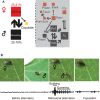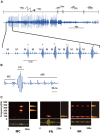Pea leafminer Liriomyza huidobrensis (Diptera: Agromyzidae) uses vibrational duets for efficient sexual communication
- PMID: 29676516
- PMCID: PMC7379950
- DOI: 10.1111/1744-7917.12598
Pea leafminer Liriomyza huidobrensis (Diptera: Agromyzidae) uses vibrational duets for efficient sexual communication
Abstract
The pea leafminer (Liriomyza huidobrensis) is a notorious pest of vegetables and ornamental plants worldwide. Despite a large number of studies on its biology and ecology, the courtship behavior and sexual communication of this species remain unclear. Here, we studied vibrational communication in the sexual interaction of the pea leafminer. On host plant leaves, females and males behaviorally displayed the bobbing-quivering alternation, which finally led to copulation. Moreover, records of laser vibrometry revealed three-signal duets underlying the behavioral alternation. Sexually mature males spontaneously emitted calls (MCs) to initiate the duets. The females rapidly responded to MCs by emitting replies (FRs) that are longer in duration. The FRs further triggered male replies (MRs) in their search for potential partners. Leafminer-produced vibrational signals convey efficient information to partners and generate pair formation on stretched substrates, such as plant leaves and nylon mesh, but cannot elicit responses on dense substrates, such as glass and plastic. Vibrational playbacks of both MCs and FRs can elicit replies in females and males, respectively. This study completely characterizes substrate-borne vibrational duets in a dipteran insect. The discovery of vibrational sex signals in the pea leafminer provides new insights for the development of novel approaches to control the pest and its relative species.
Keywords: Liriomyza; biotremology; courtship behavior; vibrational communication.
© 2018 The Authors. Insect Science published by John Wiley & Sons Australia, Ltd on behalf of Institute of Zoology, Chinese Academy of Sciences.
Figures






References
-
- Bailey, W.J. (2003) Insect duets: underlying mechanisms and their evolution. Physiological Entomology, 28, 157–174.
-
- Batemen, P.W. (2001) Changes in phonotactic behavior of a bushcricket with mating history. Journal of Insect Behavior, 14, 333–341.
-
- Boumans, L. and Johnsen, A. (2015) Stonefly duets: vibrational sexual mimicry can explain complex patterns. Journal of Ethology, 33(2), 87–107.
-
- Broughton, W.B. (1963) Method in bio‐acoustic terminology Acoustic Behaviour of Animals (ed. Busnel R.G. ), pp. 3–24. Elsevier, Amsterdam.
MeSH terms
Grants and funding
LinkOut - more resources
Full Text Sources
Other Literature Sources

